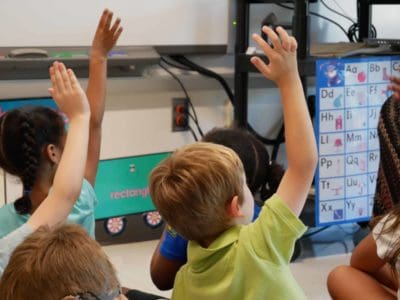

The State Board of Education talked in planning sessions all week about strategies for turning around low-performing schools. On Thursday came a large dose of reality — and a sliver of hope.
Moments after giving a standing ovation for a principal discussing his school’s turnaround efforts, the Board, at its monthly meeting, got a list of 69 failing schools that the state could take over if performance scores remain low.
Those 69 schools got the lowest scores when the state released its latest school performance grades. The state’s formula bases 80% of that grade on student achievement and 20% on growth.
Critics say the formula means that demographic metrics such as race and income drive the scores more than the progress made by teachers and students during the year. But identifying a list of browner and lower-income school populations does have the benefit of identifying those students who are least prepared, as Board Chair Eric Davis called them during the kickoff of the Board’s weeklong gathering.
It also helps to identify schools that sorely need the turnaround strategies the Board focused on this week, Board member Amy White said.
The Board had planned to consider which of those 69 schools to include in its Innovative School District (ISD), but after Senate Bill 522 passed the legislature last week and changed the rules for putting schools in the ISD, the board opted to wait.
“We all agreed that we were not ready for another school to be entered into the ISD next school year,” Legislative and Community Affairs Director Cecilia Holden said. “The General Assembly listened.“
And White said the focus isn’t just on the 69 schools presented Thursday.
“The real number for our state is 487,” she said at Wednesday’s planning session, referring to the total number of low-performing schools. “So hear me when I say urgency. It’s 487 leaders we need, so we need to get busy.”
Board members found hope in a blueprint Donnell Cannon offered from North Edgecombe High School, which used equity principles and the state’s Restart program to turn a near-failing school into one exceeding growth expectations the past three years.
Teaching for the 1, not the 1.5 million
Cannon is a young, black man who grew up in poverty, yet he talks about recognizing his privilege. He is the principal of a small, Title I school that sits in one of the poorest counties in the state, yet he talks about his students as one-percenters.
“We serve a school of the top 1% of the wealthiest kids that you could ever meet in your life,” he said. “Those kids are rich with hope. They’re rich with values. They’re rich with purpose. And they’re rich with passion.”
After two days of planning sessions, Cannon was the final keynote speaker before the State Board got down to its monthly business. His message was to look beyond the aesthetically visible and dig deeper to understand each student.
He said that each of his students is one out of 220. The emphasis is on the one. They don’t try to teach all 220 the same way because that would ignore each child’s individuality. The success he’s had at North Edgecombe is because they’ve shunned standardization and focused on getting each child what they need. And that, he said, is equity.
Equity is not about race, and it’s not about equality, he said. Using the example of two children, one who needs water and one who needs food, Cannon said equality would mean giving them both either food or water. Equity means if your child needs water, you go get them water.
“And if she wants more water,” he said, “you get her more water.”
In the context of the state school system, it means finding ways to get each student what they need rather than force something upon them that is the best guess at an average of needs for all 1.5 million students.
At North Edgecombe, if a student is drawn to math, teachers try to integrate math into the instruction of other subjects. And if students aren’t hungry for breakfast before school, the school offers a second-chance breakfast after the day begins.
“We’re different – vastly,” he said. “In many different ways. Many different life contexts, different life experiences, different cultural backgrounds, different rich and deep salient parts of our identities. And we never leverage those at school.”
How educators say turnaround can happen
A panel of teachers and principals addressed the State Board the day before Cannon spoke. They offered a number of suggestions. Board members later marveled at how many of those strategies were used by Cannon and his leadership team in their turnaround efforts.
Their message resonated with three main takeaways: the State Board can’t do this for the schools, exemplary schools that have completed turnaround should be studied, and leaders of turnaround schools must be empowered to lead through a local lens.
“We need to find the models of excellence,” said Paula Wilkins, principal at Cook Literacy Model School. “Who are those teachers getting it done? What are the data points that show us that? And how do we study them? Because sometimes we always look at low performance. But why don’t we look at the exemplars that are making it happen every day and use that to help us to turn the needle around in education to begin to replicate those practices?”
Carver Heights Elementary School principal Patrice Faison endorsed that proactive model, and turned the onus on the Board.
“You guys are spread so thin,” she said, “you’re going to either have to pick schools like [Wilkins] was talking about or you do nothing well.”
The Board’s focus, she said, should be taking away obstacles the state has placed on struggling schools.
“The first thing you can do is remove barriers,” Faison said. “There are so many things that a principal or district has to do. And then when you’re low-performing, you multiply those things. So instead of increasing my time to be in the classroom or to do some things, I am given extra evaluations I have to do.”
A common barrier mentioned was teacher evaluations, which Board member James Ford reflected back to the educators as possessing “big bulkiness and impreciseness.”
The educators told the Board that teacher evaluations in the form required by the state are not always helpful and not always indicative of a good teacher or a good principal. Which is important, they agreed, because good leaders are instrumental to turnaround.
“One of the huge attributes that you have to have as a teacher and a principal in a turnaround context is you have to be relentless,” Wilkins said. “It’s that idea of, when something is not working, what do you do to respond? … It’s having [a leader] who says, ‘Alright, it’s not working? What are you going to try that’s different now?'”
Questions in the form of answers can sometimes feel like no answer at all. But in a state where some 500 schools are in need of turnaround, the prevailing message from Wilkins and the entire educator panel was to find where turnaround does work and replicate it.
Confirmation that equity must be the guide
The Board offered a collective impression, following Cannon’s talk, that they found a turnaround success.
Cannon’s message was consistent with those of several other speakers over the course of the week, echoing the throughline of equity, which reinforced the Board’s dedication to that guiding principle driving its strategic plan.
And, Board members said afterward, confirmation that inequity has created the current gaps between high-performing schools and those needing turnaround.
On Tuesday, Jim Johnson walked the Board through Census forecasts that show an America, and a state, that is growing more “brown” and working poor. He warned of dire consequences to everyone, regardless of race or income, if inequities are not addressed. And he called on the State Board to find solutions that would prepare these children better, as student data show that these demographics are least prepared.
On Wednesday, representatives from Alamance Achieves invited the Board to play a game they created called Cradle to Career. Some players were students, given a set of life conditions and throughout the game thrown either harsh or fortuitous life events. These players either took steps forward or backward depending on the situations, while other players were asked to make difficult choices in investing “dollars” into the individual “students.” By game’s end, you saw how different life situations and events hold some people back.
Cannon’s talk, which drew the three-day meeting’s only standing ovation, resonated as a solution to the growing issues of inequity Board members heard the past few days. He got an assist from Board member Amy White, who drew inspiration from Cannon’s talk in summarizing what she learned this week.
“In summary, you have just shown us in real life what it takes to be a turnaround leader,” she said. “My assumption, moving forward, is that turnaround does not come in a box. It is not a program. It’s a leader.”
“We talked for months about individualizing instruction for kids,” White continued. “It’s about individualizing strong practices in the schools, meeting the culture where it is, and making a difference. So if you come away with nothing from the past two days — it’s about flexibility and offering leaders who see and know what’s going on in their communities the opportunity to make that change.”
When White finished speaking, the entire room broke into applause. Board member Matthew Bristow-Smith had been next in line to speak.
He swallowed the words he had planned to say and offered simply, “Ms. White, I need to hand you this mic back so you can drop it.”
Editor’s note: Donnell Cannon serves on EducationNC’s Board of Directors.


